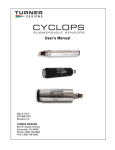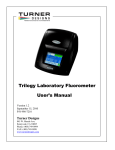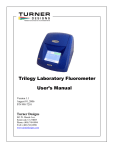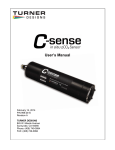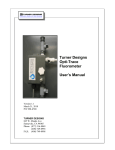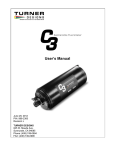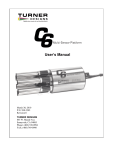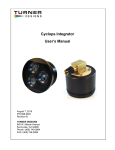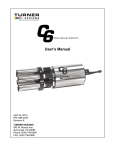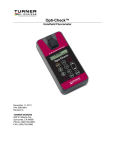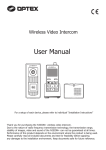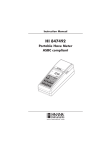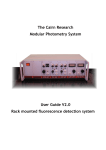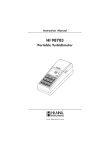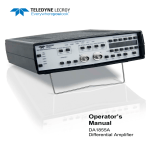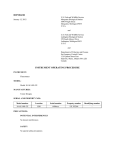Download Cyclops 7 User Manual
Transcript
CYCLOPS-7 Submersible Sensors User’s Manual Version 1.6 April 25, 2007 P/N 998-2100 TURNER DESIGNS 845 W. Maude Ave. Sunnyvale, CA 94085 Phone: (408) 749-0994 FAX: (408) 749-0 Table of Contents TABLE OF CONTENTS ................................................................................................................................... 2 INTRODUCTION................................................................................................................................................ 3 DESCRIPTION .......................................................................................................................................................3 INSPECTION AND SETUP ....................................................................................................................................3 FUNCTIONAL TEST .............................................................................................................................................4 MEASUREMENTS WITH CYCLOPS-7 ..................................................................................................... 5 INTRODUCTION ...................................................................................................................................................5 SETTING THE GAIN .............................................................................................................................................5 GAIN DETERMINATION PROCEDURE ...............................................................................................................5 TURBIDITY CYCLOPS.................................................................................................................................... 6 INTRODUCTION ...................................................................................................................................................6 CALIBRATION......................................................................................................................................................6 RECOMMENDED MEASUREMENT PRACTICES FOR USING YOUR CYCLOPS-7 IN THE LAB................................................................................................................................................................ 8 U SING THE SECONDARY STANDARD, (OPTIONAL A CCESSORY)..................................................................9 U SE OF THE SOLID SECONDARY STANDARD FOR IN VIVO CHLOROPHYLL APPLICATIONS:..................10 U SE OF THE SOLID SECONDARY STANDARD FOR DYE TRACING APPLICATIONS:...................................11 RECOMMENDED MEASUREMENT PRACTICES .............................................................................11 LINEAR RANGE AND QUENCHING..................................................................................................................11 TEMPERATURE CONSIDERATIONS..................................................................................................................12 CARE AND MAINTENANCE.......................................................................................................................12 RINSING..............................................................................................................................................................12 CLEANING THE OPTICS ....................................................................................................................................12 WARRANTY.......................................................................................................................................................13 TERMS ................................................................................................................................................................13 W ARRANTY SERVICE .......................................................................................................................................13 OUT OF W ARRANTY SERVICE ........................................................................................................................14 APPENDIX A......................................................................................................................................................15 CYCLOPS-7 SPECIFICATIONS.......................................................................................................................15 APPENDIX B ......................................................................................................................................................16 CYCLOPS-7 W IRING TABLE.........................................................................................................................16 GAIN SWITCHING TABLE .................................................................................................................................16 APPENDIX C......................................................................................................................................................17 CYCLOPS-7 PIGTAIL CABLE AND CONNECTOR INFORMATION ..............................................................17 APPENDIX D......................................................................................................................................................18 REQUEST FOR QUOTE TEMPLATE FOR NON-STANDARD PIGTAIL CABLE LENGTH/CONNECTOR FOR U SE W ITH CYCLOPS-7..................................................................................................................................18 CYCLOPS-7 User’s Manual Page 2 APPENDIX E.......................................................................................................................................................19 M ETHOD 1 - STATIC GAIN CONTROL ............................................................................................................19 M ETHOD 2 - DYNAMIC GAIN CONTROL .......................................................................................................19 INDEX ...................................................................................................................................................................21 Introduction Description The Turner Designs CYCLOPS-7 Submersible Fluorometer/Turbidimeter is an accurate single channel detector that can be used for many different applications. This instrument can be designed to detect pigment fluorescence, dye fluorescence for dye tracing applications, fluorescence of dissolved organic matter, or be used as a turbidimeter. It is intended to be integrated into a multi-parameter system to obtain its power and to deliver an output voltage to the system data logger, which is proportional to the concentration of the fluorophore, particle or compound of interest. When calibrated with a standard of known concentration, the CYCLOPS-7 output voltage can be correlated to provide data of the actual concentration of the target fluorophore. Inspection and Setup The CYCLOPS-7 shipment package consists of: • CYCLOPS-7 Analog Detector, (P/No. 2100-000) configured and factory scaled for the specified analysis, (see identification letter stamped on the connector for specified analysis, “C” = Chlorophyll, “R” = Rhodamine, “F” = Fluorescein, “P” = Phycocyanin “E” = Phycoerythrin “U” = CDOM, “O” = Crude Oil, “B” = Optical Brighteners “T”= Turbidity). • CYCLOPS-7 Documentation Kit (P/No. 2100-998) includes User’s Manual on CD (CD P/No 005-2100) and Quick Start Guide • Calibration Certificate • Quick-start Guide, Flow Through Cap assembly instructions, Secondary Standard Instructions and In Vivo Calibration Procedure all on above CD Optional Accessories include: Cable Assy-C7 Pigtail, 2 Ft, P/No. 2100-750 Solid Standard, P/No. 2100-900 Additional Equipment required for functional tests: DC Power Supply, 3 - 15 VDC, >100 mA Multimeter to read 0 – 5 VDC CYCLOPS-7 User’s Manual Page 3 Functional Test To perform a functional check on the CYCLOPS-7, connect the interface colored wires to the power supply and multimeter as shown in Figure 1. Note: Supply voltages greater than 15 VDC will result in damage to the sensor. DC Power Supply Multimeter 12.00 .015 + 3.52 - 10 VDC PSU Positive Connection, (Red) LED Light Output Supply Ground 0 VDC, (Black) + Signal Output “+” (White) CYCLOPS-7 Fluorometer Analog Ground “-” (Green) Figure 1 CYCLOPS-7 connections functional for check X10 Gain (Blue) X100 Gain (Brown) X1 (Low) Gain, Leave both wires disconnected for Functional Check With the CYCLOPS-7 connected as shown in Figure 1 above, make the following functional checks: - The LED is on The multimeter reads >0 VDC Moving the light source close to your hand causes the output voltage to increase. CYCLOPS-7 User’s Manual Page 4 - Measurements with CYCLOPS-7 Introduction The following procedure will describe how to make measurements with the CYCLOPS-7. Also, it will describe how to use the accessory Solid Secondary Standard to make absolute (or quantitative) measurements. (Note that to make accurate and repeatable measurements it is important to keep the sensor clean, see page 12 for information on cleaning your sensor). Setting the Gain The gain setting refers to the sensitivity adjustment of the sensor. There are three gain settings; X1, X10 and X100. As the gain increases, the sensitivity increases and the concentration range decreases. All three gain settings can be used, however, you must determine which gain to use prior to deployment and have an integration cable made to activate a specific gain (see Appendix B). In other words, only one gain setting can be used at a time, this is referred to as ‘Static Gain Control”. If you want the ability to utilize all three gains with a multi-parameter system, such as a CTD, you will need to purchase three separate integration cables. In most instances the X10 gain will provide the appropriate sensitivity and range. If you are working in very low concentration applications (<2 µg/L chl a or, <5 ppb rhodamine WT), the X100 gain is recommended and if very high concentrations are expected (>40 µg/L chl a or >80 ppb rhodamine WT) the X1gain is recommended. If you are uncertain of which gain setting to use you can take readings of a representative sample of water in the laboratory and determine which gain is the most appropriate. Customers wanting to dynamically change the gain ranges to achieve the optimum operating range should refer to “Method 2 – Dynamic Gain Control” in Appendix E for how to interface with a Data Collection System with programmable outputs. Gain Determination Procedure 1) For in vivo chlorophyll applications, take a natural sample of water from a sampling station where you plan to deploy the CYCLOPS-7. Applying good measurement practices, store it properly, and quickly transport it to a laboratory where you have the CYCLOPS-7 connected to a multimeter and DC power source. (see Figure 1) 2) Pour the water sample into to a clean glass beaker and submerge the optical end of the CYCLOPS-7 (See the section on “Recommended Measurement Practices for using your CYCLOPS-7 in the Lab” for how best to accomplish these steps). 3) Activate the X10 gain setting (see Wiring Table on page 16 if you believe the sample to represent a typical condition (i.e. not a bloom or other abnormal event). You would like to obtain a signal from the sample that is significantly higher than a blank sample, (De-ionized water or filtered seawater), but not a signal that is close to the maximum of 5 Volts. CYCLOPS-7 User’s Manual Page 5 4) If the sample signal is high, (>3.0 V for example) you may choose to use the X1 gain instead of the X10 gain setting so that you avoid going over scale once you deploy the CYCLOPS-7. 5) If the sample signal is very low (<0.3V) you may choose to use the X100 gain setting to achieve higher sensitivity but a smaller measurable range This process is even easier for dye tracing applications. Simply create the dye dilution of interest and record what signal level it provides on the three gain settings. Once the appropriate gain setting has been determined, order an integration cable for that particular gain. See Appendix D for more information on integration cables. Turbidity Cyclops Introduction The Turbidity Cyclops measures turbidity using an 850nm light source and detection of scattered light at a 90-degree angle, which is similar to many modern day benchtop turbidimeters. This unit provides a quick and accurate way to determine in situ turbidity, eliminating the collection and storage of samples and minimizing the potential error associated with sample handling and processing. Calibration Calibrating the Turbidity CYCLOPS is a simple process, which requires the use of calibration standards. Turner Designs recommends purchasing Amco Clear Analytical Turbidity Standards for non-ratio instruments because these standards are non-toxic safe solutions consisting mainly of de-ionized water that comes prepared in a broad range of concentrations and has a shelf life guaranteed for one year. The Turbidity CYCLOPS can be calibrated using a single point calibration, which correlates a known standard to the signal measured from a typical sample. 1) Connect the CYCLOPS-7 to a power source and measure the turbidity of a typical water sample from the source being monitored, recording the voltage output of the sample 2) Set the CYCLOPS-7 to the proper gain (see Gain Setting for explanation on how to set the gain) 3) Use turbidity standards of known concentrations (NTU) and create a correlation between the standard (NTU) and the voltage output (volts) (Note: make sure to use a standard concentration that can be read on the same gain setting as typical samples) (See page 15 for typical NTU range at gains: 1X, 10X, and 100X) 4) Once correlation has been made, use the following equation to calculate turbidity values for future measurements Sample (NTU) = [NTUStd./Std.volts] * Samplevolts NTU Std. = Concentration of Standard used for calibration CYCLOPS-7 User’s Manual Page 6 Std.volts = voltage reading from known concentration of standard Samplevolts = voltage reading from samples 5) Switching gains will require re-calibration if the signal has exceeded the maximum voltage for a gain setting CYCLOPS-7 User’s Manual Page 7 Recommended Measurement Practices for Using Your Cyclops-7 in the Lab The following steps will improve the accuracy and repeatability of your measurements, especially at low concentration levels: 1. Use a Glass Beaker for your water samples. (Avoid plastic beakers – plastic fluoresces and will interfere with the sample fluorescence) 2. Place the glass beaker on a Non-Reflective Surface, preferably black. 3. Ensure that the sensor is more than 3 inches above the bottom of the glass beaker. 4. Ensure that the sensor is in the center of the glass beaker, and has more than 2 inches clearance between the cirumference of the sensor and the inside surface of the beaker. Turner Designs recommends using a 1L Glass Beaker for measurements with CYCLOPS-7 units. 5. Check that the optical surface of the sensor is free of air bubbles. 6. Be sure your sensor is calibrated, (see page 9 for Calibration Procedure). 7. To maximize consistency between measurements, place sensor at exactly the same height for each sample. This is most easily done using a Lab Stand. Calibrated Sensor >2 inches all round Glass Beaker >3 inches No Air Bubbles On Optical Surface CYCLOPS-7 User’s Manual Dark/Black NonReflective Surface Figure 2 Summary of good measurement practices for using a submersible fluorometer in the lab. Page 8 Using the Secondary Standard, (Optional Accessory) The following information will describe how to use the Solid Secondary Standard, P/No. 2100-900, with CYCLOPS-7 sensors (Note: The Turbidity Cyclops does not have a solid secondary standard). The two main benefits of using the Solid Secondary Standard are: 1) It can be used in place of a primary liquid standard once a correlation between a primary standard and the solid standard has been established. 2) It can be used to check the stability of the instrument, and/or check for loss in sensitivity resulting from the growth of bio-fouling organisms on the sensor optics. The Solid Secondary Standard provides a very stable fluorescent signal. It has an adjustment screw so that you can tune the Solid Standard to provide a signal to match a specific sample. Installing the Secondary Standard 1) Before installing the Solid Standard you must ensure that the optical surface of the CYCLOPS-7 is completely clean and dry. The Solid Standard is indexed and it must be installed so that the indexing is precisely aligned for proper use (see Figure 3). 2) To install, place the Solid Standard on to the optical end of the CYCLOPS-7. 3) With the Solid Standard fully pressed on, rotate in either direction until you feel the CYCLOPS-7 Solid Standard indexing mark Figure 3. Align the index mark and indexing ball when installing CYCLOPS-7 in the Solid Secondary Standard. Solid Standard indexing ball Solid Standard indexing ball click into the indexing mark on the CYCLOPS-7. 4. To begin, use a flat-head screwdriver to unscrew the locking nut as far as it will go. 5. Next, to change the signal level, use the green screwdriver provided and insert the blade through the hole in the locking nut. Rotate it until it engages with the CYCLOPS-7 User’s Manual Page 9 adjustment screw that is beneath the locking nut. Now the screw can be used to adjust the signal level as necessary. Lock Nut Adjustment screw is located under the locking nut Figure 4 Insert the supplied green screwdriver through the calibration hole in the locking nut to reach the adjustment screw. 6. Once the desired reading has been obtained, the locking nut should be screwed down so that the adjustment screw is held firmly in place. 7. Finish by noting the output voltage and gain setting used, (X1, X10 or X100) in the “Value” space on the Secondary Standard label 8. Note that the response of every solid standard is unique. Hence, a new correlation must be determined for every sensor. For future identification, use the “ID” space on the label for a unique identifier for the Secondary Standard. Use of the Solid Secondary Standard for In Vivo Chlorophyll Applications: 1. To establish a correlation between a known chlorophyll concentration and the fluorescence output voltage immerse the sensor in a sample containing algae and note the sensor output voltage and gain setting used, (x1, x10 or x100). 2. Dry off the CYCLOPS-7, attach the Solid Standard, (with the same gain setting), and adjust the Solid Standard to produce the same output voltage from the sensor as in step 1, (turning the Secondary Standard adjustment screw clockwise produces a lower signal). 3. Next, perform a chlorophyll extraction using a Laboratory Fluorometer, Spectrophotometer or HPLC to determine the actual chlorophyll a concentration in the sample 1 . This will provide the correlation of actual chlorophyll a concentration for the sensor output voltage at that given gain setting. 4. Now, at any time, the Solid Standard can be used to check/establish a new correlation between a known equivalent concentration and the current 1 Information on doing a chlorophyll extraction can be found on the Turner Designs web site at this URL: http://www.turnerdesigns.com/t2/doc/appnotes/998_9000.html CYCLOPS-7 User’s Manual Page 10 CYCLOPS-7 output voltage, (CYCLOPS-7 must be on the same gain setting as in Step 1). Use of the Solid Secondary Standard for Dye Tracing Applications: The Solid Secondary Standard accessory can also be used to check the fluorescence stability for making dye concentration measurements. If necessary, the Solid Standard can be used to establish a new correlation voltage without the need to use a calibration solution each time. 1. To use the Solid Standard to establish a correlation between a known dye concentration and the fluorescence output voltage, immerse the sensor in a dye solution of known concentration, say 50 ppb, and note the sensor output voltage and gain setting used. 2. Dry off the optical end of the CYCLOPS-7, attach the Solid, and adjust to produce the same output voltage from the sensor as in step 1, (turning the secondary standard adjustment screw clockwise produces a lower output). 3. Now, at any time, the Secondary Standard can be used to check/establish a new correlation between a known equivalent concentration and the current CYCLOPS-7 output voltage. 4. Comprehensive information on dye trace measurements can be found at the following Turner Designs URL: http://www.turnerdesigns.com/t2/doc/appnotes/main.html#fluorescent (Note: There is no Solid Secondary Standard available for Turbidity Cyclops) Recommended Measurement Practices Linear Range and Quenching The linear range is the concentration range in which the CYCLOPS-7 output is directly proportional to the concentration of the signal. The linear range begins with the smallest detectable concentration and spans to an upper limit (concentration) that is dependent upon the properties of the material, filters used, and path length. A non-linear relationship is seen at very high concentrations where the signal does not increase at a constant rate in comparison to the change in concentration, see Figure 5 below. At even higher concentrations, the signal will decrease even though the sample concentrations are continuing to increase. This effect is known as “signal quenching”. Linearity can be checked by diluting a sample 1:1 or some other convenient ratio. If the sample is still in the linear range, the reading will decrease in direct proportion to the dilution. If the reading does not decrease in direct proportion to the dilution, or if the reading increases, the sample is beyond the linear range. CYCLOPS-7 User’s Manual Page 11 Fluorometer Reading Fluorometer Response Curve Sample Quenching Region Sample Linear Region Sample Concentration Figure 5 Graph showing Linear and Quenching Regions of the sample’s response Temperature Considerations Fluorescence is temperature sensitive. As the temperature of the sample increases, the fluorescence decreases. For greatest accuracy, record the sample temperature and correct the sensor output for changes in temperature. For further information on how temperature, light, water quality and the physiological state of the algal cells can all affect the measurement of chlorophyll a, please refer to the application section of Turner Designs’ web site at the following URL: http://www.turnerdesigns.com/esupport/understanding.html Care and Maintenance Rinsing The CYCLOPS-7 should be rinsed or soaked in freshwater following each deployment, ideally until it is completely clean again. Cleaning the Optics The optical window should be visually inspected after each deployment following a soaking in fresh water. If cleaning is needed, use optical tissue to clean the window with soapy water. Note: The CYCLOPS should not come in contact with any organic solvents (ie. acetone, methanol) or strong acids and bases. The UV Cyclops-7 models are the ONLY Cyclops-7 sensors that can be calibrated with Quinine Sulfate standards made in Hydrosulfuric Acid. All other Cyclops-7 models CAN NOT be used in Hydrosulfuric Acid. CYCLOPS-7 User’s Manual Page 12 Warranty Terms Turner Designs warrants the CYCLOPS-7 Fluorometer/Turbidimeter and accessories to be free from defects in materials and workmanship under normal use and service for a period of 12 months from the date of shipment from Turner Designs with the following restrictions: The instrument and accessories must be installed, powered and operated in compliance with the directions in this CYCLOPS-7 User’s Manual and directions accompanying the accessories. Damage incurred in shipping is not covered Warranty Service To obtain service during the warranty period, the owner shall take the following steps: Write or call the Turner Designs Technical Support Department and describe as precisely as possible the nature of the problem. Phone: 1 (877) 316-8049 E-Mail: [email protected] Carry out minor adjustments or tests as suggested by the Technical Support Department. If proper performance is not obtained, ship the instrument, prepaid, to Turner Designs, with a statement of shipping charges. The instrument will be repaired and returned free of charge, along with a check to cover shipping charges, for all customers in the contiguous continental United States. For customers outside of the contiguous continental United States, and who have purchased our equipment from one of our authorized distributors, contact the distributor. If you have purchased direct, contact us. We will repair the instrument at no charge: shipment; documentation; etc; charges will be billed at cost to the customer. NOTE! The instrument or accessories should not be returned without first contacting Turner Designs. Prior correspondence, including an RMA number is needed: a. To ensure that the problem is not a customer solvable one, easily handled in your laboratory, saving the end-user time and money. b. To specifically determine the nature of the problem, so that repair can be rapid, with particular attention paid to the defect you have noted. CYCLOPS-7 User’s Manual Page 13 Out of Warranty Service Proceed exactly as for Warranty Service, above. If our service department can assist you by phone or correspondence, we will be glad to, at no charge. Repair service will be billed on a fixed price basis, plus any applicable duties and/or taxes. Shipment to Turner Designs should be prepaid. Your bill will include return shipment freight charges. Address for Shipment: Turner Designs 845 W. Maude Ave., Sunnyvale, CA 94085 Phone: (408) 749-0994 CYCLOPS-7 User’s Manual Page 14 Appendix A CYCLOPS-7 Specifications Parameter Minimum Detection Limit Dynamic Range (Depends on gain setting) Linearity, (over dynamic range for lab environment) Specification 0.03 µg/L Chlorophyll a 0.04 ppb Rhodamine WT 150 cells/mL Cyanobacteria 0.04 NTU Turbidity X1: 0 – 500 µg/L, Chl a X10: 0 – 50 µg/L, Chl a X100: 0 – 5 µg/L, Chl a X1: 0 – 1,000 ppb, RWT X10: 0 – 100 ppb, RWT X100: 0 – 10 ppb, RWT X1: 0 – 2,000,000 cells/mL PC or PE X10: 0 – 200,000 cells/mL PC or PE X100: 0 – 20,000 cells/mL PC or PE X1: 0 – 3000 NTU, Turbidity X10: 0 – 1000 NTU, Turbidity X100: 0 – 100 NTU, Turbidity 0.99R2 Power Draw @3V: Max 360 mW =5V: Max 265 mW Input Voltage 3 – 15 VDC Signal Output 0 – 5 VDC Temperature Range Ambient: 0 to 50 °C Light Source Light Emitting Diode Excitation Wavelength Detector Chl 460 nm, RWT 550 nm, PC 595 nm, PE 528 nm, Turbidity 850 nm Chl 620 - 715 nm, RWT 590 - 715nm PC 670 nm, PE 573 nm, Turbidity 850 nm Photodiode Detection Wavelength 300 – 1,100 nm Warm up time 5 seconds Dimensions, (length excludes connector) Length: 4.3”, 10.9cm Weight 5.0 ozs, 160 gm Depth Rating 600 meters Housing Material 316 Stainless Steel Emission Wavelength CYCLOPS-7 User’s Manual Water Temp: -2 to +50 °C Diameter: 0.875”,2.22cm Page 15 Appendix B CYCLOPS-7 Wiring Table CYCLOPS- 7 Wire Pin Number Red 1 Function Connection Supply Voltage PSU – Positive Connection 3 – 15 VDC Black 2 Supply Ground, 0VDC PSU – Ground Connection White 3 Signal Out to data logger, “+”, 0 – 5VDC Multimeter Positive Connection Green 4 Analog Ground “-”, 0 VDC Multimeter Negative Connection Blue 5 X10 Gain, (Medium Sensitivity) See table below Brown 6 X100 Gain, (High Sensitivity) See table below Gain Switching Table Gain 10 (Blue) Gain 100 (Brown) Gain Chl Range (µg/L) RWT Range (ppb) TRB Range (NTU) Not connected Not connected X1 0 - 500 0 – 1,000 0-3000 Connected to analog ground Not connected X 10 0 – 50 0 - 100 0-1000 Not connected Connected to analog ground X 100 0–5 0 - 10 0-100 CYCLOPS-7 User’s Manual Page 16 Appendix C CYCLOPS-7 Pigtail Cable and Connector Information Figure 7 Dimension details of 24” length cable with 20 gauge colored leadwire, connects to 6 Figure 8 Female locking sleeve, (Impulse P/No. MCDLS-F) Figure 9 In-line connector contact configuration, (connects to CYCLOPS-7). See Appendix D for a Quote Request template to order a non-standard pigtail cable length/connector for use with the CYCLOPS-7 Fluorometer pin male connector. (Cable manufacturer/Part No: IMPULSE/MCIL-6-FS) A Maximum cable length up to 300 meters can be connected to the CYCLOPS if the following conditions are met. 1) The cable is shielded and contains 20 gauge conductor size or greater (ie Belden No. 8426 cable). 2) The 0-5 volt Analog output is connected to a device (ie Data Logger) with an input impedance of 1 MegOhm or greater. 3) The supply Voltage to the CYCLOPS is between 5 and 15 volts. CYCLOPS-7 User’s Manual Page 17 Appendix D Request for Quote Template For Non-Standard Pigtail Cable Length/Connector For Use With CYCLOPS-7 To request a quote from Impulse Enterprise for a custom pigtail cable/connector, follow these steps: I) II) III) IV. V. Complete the 6 lines below between the asterisks (*) with your specific information. Highlight the lines between the asterisks (*) and copy to the PC clipboard. Paste the information into the “Comments” field on the Contact Us page on the Impulse Enterprise web page at the following URL: http://www.impulse-ent.com/inquiry.html Complete the remaining fields of the Impulse Enterprise <Contact Us> e-mail form Click on “Send E-Mail”. ************************************************* Please quote for a custom pigtail cable/connector for use with Turner Designs CYCLOPS-7 fluorometer to meet the following requirements: 1. Pigtail is required for integration with ____________________ (Identify multi-parameter system as appropriate) 2. Cable Length (to include connectors)___________, (see Page 15 for max length) (State units, feet, meters, etc.) 3. Configured for ____X1, ____X10, _____X100 gain range on CYCLOPS-7 (Put a checkmark against desired gain) 4. Required connector on non-CYCLOPS end of pigtail: _____________________ (Provide sufficient information for Impulse Enterprise to request a quote for the required “host” end of cable) 5 Pin out from Host End to CYCLOPS end: _______________________________ or advise: a. Supply Voltage (+) from Host is carried on pin _______ b. Supply Ground from Host is carried on pin ________ c. Analog Signal to Host is carried on pin _______ d. Analog Ground to Host is carried on pin _______ Provide sufficient information for Impulse Enterprise to make the proper electrical hook-up between the two connector ends) 6. No. of Pigtails required_____________________ (Provide contact details if different from your information entered in the Impulse Enterprises fields on their “Contact Us” e-mail form. For assistance from Turner Designs, call 1 877 316-8049 For assistance from Impulse Enterprise, call 1 800 327-097 CYCLOPS-7 User’s Manual Page 18 Appendix E Controlling the Gain of CYCLOPS-7 The operating range can either be set to one of the 3 available ranges, which will be referred to as "Static Gain Control"; or it can be dynamically changed to achieve the optimum operating range, referred to below as "Dynamic Gain Control". The first approach is applicable to using the CYCLOPS-7 as a stand-alone sensor. The second approach is applicable to when the CYCLOPS-7 is integrated into a system with control capability. Both methods are implemented by grounding or driving Low the appropriate Gain Control pin. The X10 and X100 Gain Control pins are normally in a "1" or "High" state if they are not connected to anything. This means the CYCLOPS default is to be in the X1 (largest concentration range) mode. The CYCLOPS-7 can be put into higher gain, lower concentration range modes by connecting either the X10 or X100 pin (but not both at the same time) to ground. Method 1 - Static Gain Control Connect the X10 or X100 pin to the analog ground pin of the CYCLOPS-7 pigtail connector. See the Gain Switching Table in Appendix B to determine the required configuration for desired gain range/measurement range. See Appendix C for Pigtail Cable and Connector information. Also, see “Setting the Fluorometer Gain” on page 5 for more information on “Static Gain Control”. Method 2 - Dynamic Gain Control If you have a Data Collection System (DCS) that has programmable outputs you can use them to control the CYCLOPS-7 gain signals. Following are three common output types found in Data Collection Systems and how to connect them to the CYCLOPS-7. Refer to the manual of your DCS to determine which is appropriate. For those who want the technical data: the X10 and X100 Gain Control pins of the CYCLOPS-7 are connected internally to the input of a Schmitt trigger inverter, part number 74LVC1G14, and a 100K ohm pull-up resistor. Both use a 5-Volt power supply. Output type 1: Digital Signals Logic signals can be used to drive the Gain Control pins. In most cases you can connect the digital signal output of the DCS directly to the CYCLOPS-7 Gain Control pins. To drive them high, the voltage should be 3.0 volts minimum, 5 volts maximum. To drive them low, the voltage should be 1-Volt maximum, 0 Volts minimum. You may need to connect the CYCLOPS-7 analog ground to the DCS ground. Output type 2: Open Collector Signals This type of output is either open or connected to ground. Connect the CYCLOPS-7 Gain Control pins directly to these outputs. You may need to connect the CYCLOPS-7 analog ground to the DCS ground. Output type 3: Relays CYCLOPS-7 User’s Manual Page 19 Relays act as a controllable switch. Connect one end of the relay to the CYCLOPS-7 analog ground. Connect the other end of the relay to the CYCLOPS-7 Gain Control pin. CYCLOPS-7 User’s Manual Page 20 Index A O Analog Ground “-”,........................................... 16 Analog Output voltage “-”,.............................. 16 Analog Output voltage “+”,............................. 16 optical window...................................................12 Out of Warranty Service...................................14 D Description ........................................................... 3 Detector............................................................... 15 Dynamic Range ................................................. 15 E Emission Wavelength....................................... 15 Excitation Wavelength..................................... 15 P Power Draw.........................................................15 PSU – Ground Connection...............................16 PSU – Positive Connection..............................16 R Rinsing.................................................................12 S Gain switching signal 1 .................................... 16 Gain switching signal 2 .................................... 16 Signal Out to data logger,.................................16 Solid Standard ......................................................3 Supply Ground ...................................................16 Supply Voltage...................................................16 I T Input Voltage ..................................................... 15 Temperature Range............................................15 temperature sensitive.........................................12 Turbidity................................................................6 G L LED........................................................................ 4 Light Source....................................................... 15 linear range......................................................... 11 Linearity.............................................................. 15 W Warranty..............................................................13 Warranty Service................................................13 M Minimum Detection Limit ............................... 15 CYCLOPS-7 User’s Manual Page 21 Turner Designs 845 W. Maude Ave. Sunnyvale, CA 94085 Phone: (408) 749-0994 Toll Free (877) 316-8049 © Copyright 2003, 2004 Turner Designs P/No. 998-2100 CYCLOPS-7 User’s Manual Page 22






















